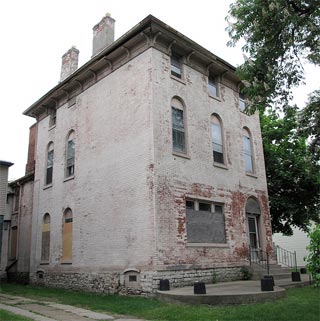Common Council Report
by Ellen Przepasniak
Wilkeson House historic, homesteading program expanded, nonpartisan elections on the table

The Common Council made two key decisions Tuesday in the often (and often unnecessarily) opposed names of development and preservation. On one hand, they called for expanded eligibility for the city’s Urban Homesteading Program so that citizens can more easily purchase and develop plots of vacant land in the city. On the other, they butted heads against the Buffalo and Fort Erie Public Bridge Authority to award landmark status to a home scheduled to be demolished to make way for a proposed new bridge plaza.
In what was supposed to be a routine approval of a list of newly eligible properties designated as “urban renewal areas,” the Council took the vote a step further. Councilmembers approved a list of 86 new lots that qualify under the current requirements, but there was united support for expansion of the current map to include more of the city’s neighborhoods where vacant lots abound. The city’s Urban Homesteading Program allows residents of certain neighborhoods to buy vacant lots adjacent to their properties for $1, but the current map and street list were drawn up in the 1950s along with the city’s outdated housing code. North District Councilmember Joe Golombek offered his support for expansion of the map, wishing his residents could purchase and develop vacant lots in what he calls the “tilting” neighborhoods of Black Rock and Riverside—residents who aren’t always able to pay the thousands of dollars these lots can cost.
When purchased, these vacant lots return to the tax roll, the city doesn’t have to maintain the properties and the residents who buy them can put them to uses other than the dumping grounds they often become. “It’s a win-win if it’s adjacent property,” Golombek says.
Meantime, in an attempt to preserve a slice of Buffalo’s architectural and historical significance, councilmembers voted Tuesday to designate a home at 771 Busti Avenue on the city’s West Side a historical landmark. The house was slated for demolition by the PBA as part of bridge and plaza expansion. Col. Samuel Wilkeson—the grandson of the architect of Buffalo’s harbor and a Civil War soldier—lived in the house, which was built in 1863. The structure is an example of the Italianate style of architecture, which is scattered throughout the city, most notably on Tracy Street downtown. The Council has considered relocation of the house, but the city’s Preservation Board quickly dismissed that idea due to cost. The empty structure is ideal for a museum or historic home, which is what the Council hopes to see there in the future. “When you have such a cut-and-dry case…to vote no would be going against the grain,” says Lovejoy District Councilmember Richard Fontana.
The Council also passed a resolution sponsored by Golombek to further explore nonpartisan elections, which would expand primary votes beyond political affiliation. Nonpartisan elections may have prevented what happened in last month’s mayoral primary, in which only registered Democrats could decide who the city’s next mayor would be, given the lack of second- or third-party candidates. South District Councilmember and mayoral candidate Michael Kearns supports the change. “Parties are important at the state and federal level, but at the local level, people vote for the person,” Kearns says. “Some people don’t fit in to cookie-cutter ideals.”
Councilmembers hope to have a referendum on nonpartisan elections ready for the ballot by November 2010.
—ellen przepasniak
blog comments powered by Disqus|
Issue Navigation> Issue Index > v8n42 (Week of Thursday, October 15th) > The News, Briefly > Common Council Report This Week's Issue • Artvoice Daily • Artvoice TV • Events Calendar • Classifieds |









 Current Issue
Current Issue